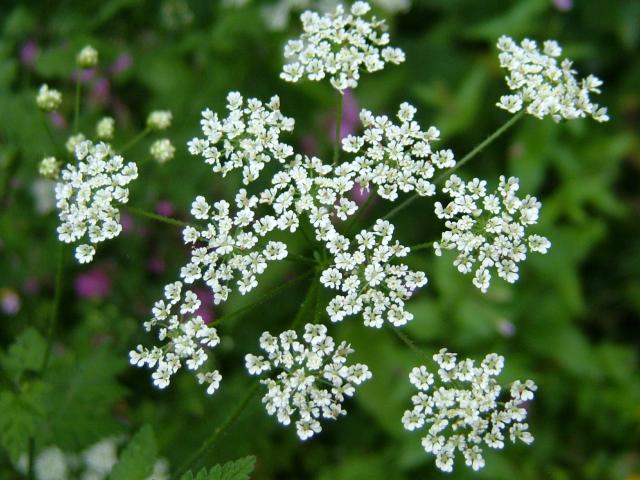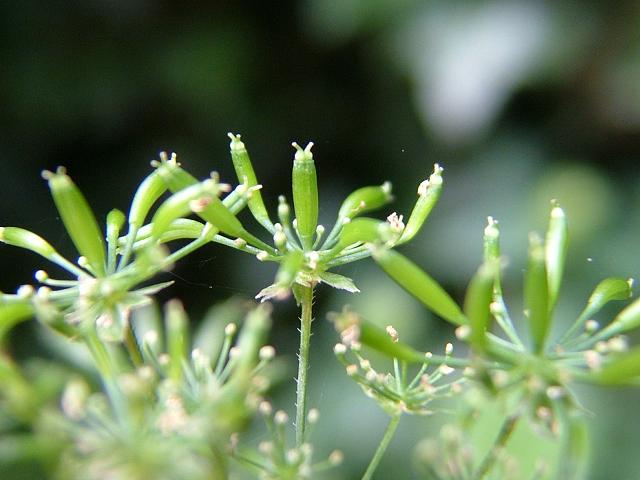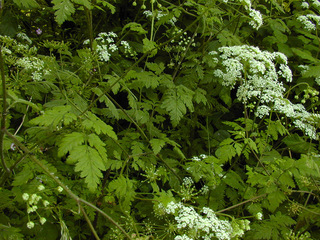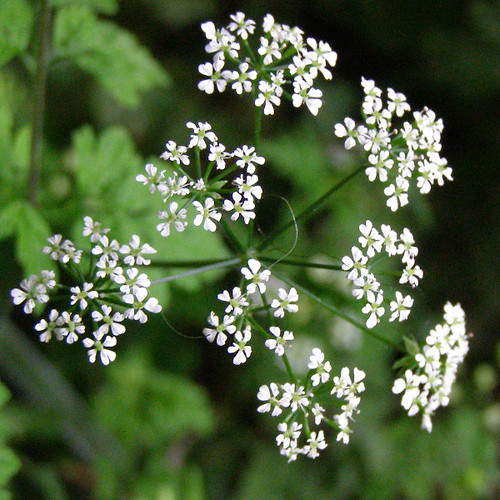Chaerophyllum temulum
Hedge chervil ( Chaerophyllum temulum ), illustration
The Hedge chervil ( Chaerophyllum temulum ), also tumbling chervil, chervil or swash - Numbing called chervil, is a plant which belongs to the parsley family ( Apiaceae ).
Description
The Hedge Chervil grows as a biennial herbaceous plant growth and reached heights of up to 1.40 meters. It sprouts a fleshy " rootstock " several stems. The branched stems are round, but slightly wrinkled and covered with bristles that provide on contact for painful skin contact. Towards the base, the stems covered by dark red spots on and through club-like swellings on the branches that have this plant genus introduced the trivial names chervil. The leaves of the swash - calf goitre are pinnate and rauhaarig twice. The smell of the plant is weak spicy, reminiscent of carrot and cumin.
The white, only 2 to 4 millimeters wide flowers are grouped in six-to zwölfstrahligen, doppeldoldigen inflorescence. The fruits are about 1 inch long.
Ecology
The flowering period is May to July. The flowers are vormännliche " nectar leading disk flowers " with male and hermaphrodite flowers ( andromonözisch ). They are pollinated by insects.
The fruits are bald Doppelachänen; they remain in the winter on the plant ( Winter Stayers ). The fruits are part in initiating the mature, dry stalks far flung away (Animal spreader ); presumably they are also spread by the wind. The fruits ripen from July to September.
Occurrence and risk
The Hedge Chervil grows on forest edges and meadows. He prefers to grow on nitrogen- rich, moist meadows, but spreads out quite well in drier terrain. The plant, including from plentiful, but nevertheless declined sharply in some areas. In the phytosociological system of hedge Chervil is a Kennart the Knoblauchhederich - Saumgesellschaft ( Alliario petiolati - Chaerophylletum temuli ).
The distribution areas of the hedge chervil are in most of Europe, except in the northern and southern region, to the north west African states of Morocco, Algeria and Tunisia, in northern Turkey and the northern Caucasus region.
The Austrian deposits are frequently to rarely; in East Tyrol, the hedge Chervil is extinct; the Carinthian deposits are impermanent. In the Alpine region of Austria as well as the northern and south-eastern foothills of the Alps, he is considered endangered.
System
Chaerophyllum temulum was first described by Carl Linnaeus in 1753 in Species Plantarum, Volume 1, page 258. A synonym for Chaerophyllum temulum is Chaerophyllum L. temulentum.
Toxicology
Animals that eat the calf crop, stagger and suffer paralysis. The toxic effect is probably due to the content on polyyne Falcarinol. Assumptions in the earlier literature on a not yet isolated alkaloid ( Chaerophyllin ) could not be confirmed. For people of the swash - Chervil is only slightly toxic due to the low toxin content. Earlier reports of severe or fatal intoxications are due probably to avoid confusion with the spotted hemlock ( Conium maculatum ).
There are other Chervil species such as the Hairy Chervil, the bulbous chervil or gold chervil. However, these are not toxic.






.jpg)



